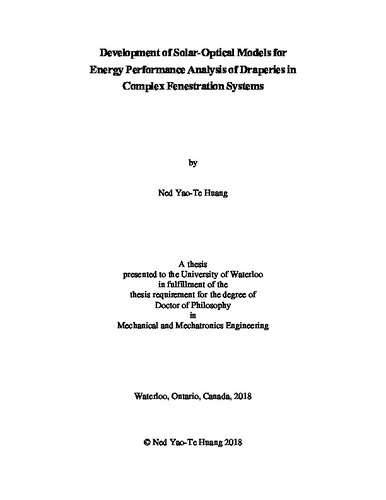| dc.contributor.author | Huang, Ned Y.T. | |
| dc.date.accessioned | 2018-02-21 15:09:00 (GMT) | |
| dc.date.available | 2018-02-21 15:09:00 (GMT) | |
| dc.date.issued | 2018-02-21 | |
| dc.date.submitted | 2018-02-16 | |
| dc.identifier.uri | http://hdl.handle.net/10012/13015 | |
| dc.description.abstract | Window coverings have been used for many years to provide protection from undesired environmental conditions and to regulate indoor conditions. Models for complex fenestration systems (CFS), a term coined in the early 90’s in light of optical and thermal complexity of shading elements, are essential in pursuing multiple objectives of modern building design. This research focuses on energy performance of one type of window shading, draperies.
Coupled with a rectangular pleated drape model, the conventional three-property Keyes Universal Chart (KUC) predicts shading effect of pleated drapes. This thesis offers a much improved KUC, the b&C model, which was developed using fabric solar-optical properties obtained by a highly accurate spectrophotometer. The improved KUC has largely eliminated the bias and reduced the uncertainty present in the original KUC. The b&C model, also a three-property KUC, uses manipulative functional relationships. A fourth property, fabric thickness, was explored to better correlate the three-property relationships, resulting in the customized KUC for increased accuracy.
Previous pleated drape models comprised only rectangular pleats (i.e., RPD). A triangular pleated drape (TPD) model was built for comparison with RPD. In parallel, an experiment was designed to measure and study the effects of fullness, pleating profile, and angle of incidence for selected fabrics. A comprehensive set of transmittance test results was attained using the Broad Area Illuminating Integrating Sphere (BAI-IS) system. Both RPD and TPD models were assessed with the experiment. Discussions on the effects of variables are offered.
The improved/customized KUC combined with a RPD/TPD model can be implemented in building energy simulation software or used as a stand-alone tool to determine the shading effect of a pleated drape on the solar heat gain. | en |
| dc.language.iso | en | en |
| dc.publisher | University of Waterloo | en |
| dc.subject | Complex Fenestration Systems | en |
| dc.subject | Keyes Universal Chart | en |
| dc.subject | Solar Optical Models | en |
| dc.subject | Solar Heat Gain Coefficient | en |
| dc.subject | Pleated Drape Models | en |
| dc.subject | Broad Area Illumination Integration Sphere | en |
| dc.title | Development of Solar-Optical Models for Energy Performance Analysis of Draperies in Complex Fenestration Systems | en |
| dc.type | Doctoral Thesis | en |
| dc.pending | false | |
| uws-etd.degree.department | Mechanical and Mechatronics Engineering | en |
| uws-etd.degree.discipline | Mechanical Engineering | en |
| uws-etd.degree.grantor | University of Waterloo | en |
| uws-etd.degree | Doctor of Philosophy | en |
| uws.contributor.advisor | Collins, Michael | |
| uws.contributor.advisor | Wright, John | |
| uws.contributor.affiliation1 | Faculty of Engineering | en |
| uws.published.city | Waterloo | en |
| uws.published.country | Canada | en |
| uws.published.province | Ontario | en |
| uws.typeOfResource | Text | en |
| uws.peerReviewStatus | Unreviewed | en |
| uws.scholarLevel | Graduate | en |

